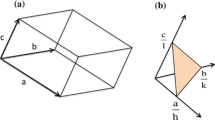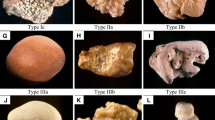Abstract
In our laboratory more than 100,000 urinary calculi have been analysed since 1972. Amongst this huge sample, 15 specimens originating from a total of eight patients were observed showing similar characteristics but escaping unambiguous identification with any of the substances that have been described so far in urinary concrements. Therefore, the unknown substance was submitted to a more extended analytical regimen. Structural analysis by x-ray crystallography turned out to be most successful, identifying the unknown material as uric acid monohydrate. Uric acid monohydrate crystallizes in the monocline space group P21/c. Within the crystal, uric acid and water molecules form continuous layers by hydrogen bonds. This is in contrast to uric acid in its water free and its dihydrate forms, which both crystallize by forming 3-dimensional networks To the best of our knowledge , the existence of a monohydrate form of uric acid has not been reported so far. Accordingly, this is the first report on uric acid monohydrate as a urinary stone component. The frequency of only 0.015% in our survey indicates that uric acid monohydrate is rarely the main component in concrements, in contrast to uric acid and uric acid dihydrate with frequencies of 10% and 6%, respectively. The infrared spectrum of uric acid monohydrate is very similar to that of the other crystal forms of uric acid. Because of this similarity and its low frequency, uric acid monohydrate may have been overlooked as a component of urinary concrements. X-ray diffraction allows for better differentiation in routine stone analysis. All samples of uric acid monohydrate were found by solid state NMR spectroscopy to be highly contaminated by amorphous material. This material consisted of long aliphatic chains reminiscent of lipids and fatty acids, respectively. Concrements consisting of other forms of uric acid or urate lacked this amorphous component. Therefore, a role of this aliphatic material has to be taken into consideration when discussing the conditions that may favour the rare formation of concrements from uric acid monohydrate. As for as the metabolic situation of the affected patients is concerned, no common peculiarities became evident by a retrospective survey.






Similar content being viewed by others
References
Schubert G (1996) 70,000 urinary stone analyses—analytical and metaphylactic apects. In: Pak CYC, Resnick MI, Preminger GM (eds) Urolithiasis 1996. Millet, Dallas, p 452
Shirley R (1999) CRYSFIRE an interactive powder indexing support program. University of Surrey, Guildford
Kraus W, Nolze G (2001) PowderCell Version 2.4. Bundesanstalt für Materialforschung und –prüfung, Berlin
Egert E, Sheldrick G (1985) Search of fragment of known geometry by integrated patterson and direct methods. Acta Cryst A 41: 262
Reck G (1990) CAVITY. Bundesanstalt für Materialforschung und –prüfung, Berlin
Sheldrick G (1997) SHELXL-97. University Göttingen, Göttingen
Reck G (1999) Röntgenstrukturanalyse aus Pulverdiffraktionsdaten. Workshop, Universität Frankfurt am Main, 27–30 September 1999
Ringertz H (1966) The molecular and crystal structure of uric acid. Acta Cryst 20: 397
Parkin S, Hope H (1998) Uric acid dihydrate. Acta Cryst B 54: 339
Kalinowski H-O, Berger S, Braun S (1984)13C NMR Spektroskopie. Georg Thieme, Stuttgart
Grases F, Villacampa A, Costa-Bauza A, Söhnel O (2000) Uric acid calculi: types, etiology and mechanism of formation. Clin Chim Acta 302: 89
Acknowledgment
The authors are grateful to Dr. S. Rogaschewski (Institute of Physics, Humboldt University Berlin,) for the preparation of scanning electron micrographs and to Karin Adam for performing the electron microprobe measurements.
Author information
Authors and Affiliations
Corresponding author
Rights and permissions
About this article
Cite this article
Schubert, G., Reck, G., Jancke, H. et al. Uric acid monohydrate—a new urinary calculus phase. Urol Res 33, 231–238 (2005). https://doi.org/10.1007/s00240-005-0467-5
Received:
Accepted:
Published:
Issue Date:
DOI: https://doi.org/10.1007/s00240-005-0467-5




